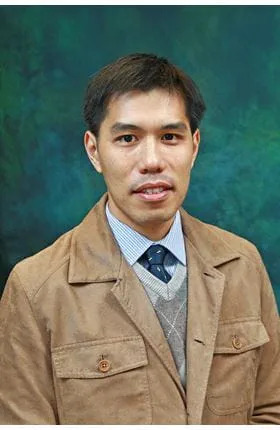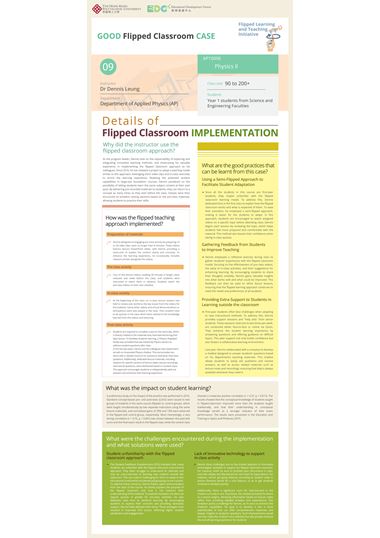
General Information
- Instructor: Dr Leung C.W., Dennis
- Department: Department of Applied Physics
- Subject: AP10006 Physics II
- Class Size: 90 to 200+
- Students: Year 1 students from science and engineering faculties
Why Use the Flipped Classroom Approach?
Implementation Steps
Dennis designed an engaging pre-class activity by preparing 10 to 20 video clips, each no longer than 8 minutes. These videos feature lecture PowerPoint slides, with Dennis providing a voice-over to explain the content clearly and concisely. To enhance the learning experience, he occasionally includes relevant articles alongside the videos.
Pre-class activity
Four to five lecture videos, totalling 30 minutes in length, were released one week before the class, and students were instructed to watch them in advance. Students watch the pre-class videos on their own initiative.
In-class activity
At the beginning of the class, an in-class lecture session was held to review and reinforce the key issues from the videos for the students. Some other videos and virtual demonstrations or stimulations were also played in the class. Then student have to do quizzes in the class which were related to the knowledge learned from the videos and lecturing.
Post-class activity
Students are required to complete a quiz on the same day, which is directly related to the materials they have learned during that day’s lesson. To facilitate students’ learning, a ‘Physics Helpdesk’ facility was provided that was hosted by Physics seniors to address student questions after class.
In the last two years, Dennis and his colleagues have experimented with an AI-assisted Physics chatbot. This tool provides students with a reliable resource for assistance whenever they have questions. Additionally, dedicated lecture materials, including citations for specific sections of lecture slides, lecture recordings, and tutorial questions, were distributed based on student input. This approach encourages students to independently seek out answers and enhances their learning experience.
What Impact Did This Have on Student Learning?
stronger indicator of their exam performance. The results were presented in the Education and Training in Optics and Photonics 2019.
What Are the Good Practices That Can Be Learnt from This Case?
Since all the students in this course are first-year students, they maybe unfamiliar with the flipped classroom learning model. To address this, Dennis dedicated time in the first class to explain how the flipped classroom works and what is expected of them. To ease their transition, he employed a semi-flipped approach, making it easier for the students to adapt. In this approach, students are encouraged to watch assigned videos on a specific topic before attending class. Dennis begins each session by reviewing the topic, which helps students feel more prepared and comfortable with the material. This method also boosts their confidence when taking in-class quizzes.
Gathering Feedback from Students to Improve Teaching
Dennis employed a reflective exercise during class to gather students’ experiences with the flipped classroom model, focusing on the effectiveness of pre-class videos, the value of in-class activities, and their suggestions for enhancing learning. By encouraging students to share their thoughts candidly, Dennis gains valuable insights into what works well and what could be improved. This feedback can then be used to refine future lessons, ensuring that the flipped learning approach continues to meet the needs and preferences of all students.
Providing Extra Support to Students in Learning outside the classroom
First-year students often face challenges when adapting to new instructional methods. To address this, Dennis provides support sessions and "help aids" from senior students. These sessions, held one to two times per week, are conducted either face-to-face or online via Zoom. They enhance the student learning experience by answering questions and offering guidance on difficult topics. This peer support not only builds confidence but also fosters a collaborative learning environment.
Last year, Dennis collaborated with a company to develop a chatbot designed to answer students’ questions based on his department’s teaching materials. This chatbot allows students to easily ask questions and receive answers, as well as access related materials such as lecture notes and recordings, ensuring that help is always available whenever they need it.
What Were the Challenges Encountered During the Implementation and What Solutions Were Used?
The Student Feedback Questionnaire (SFQ) indicates that many students are unfamiliar with the flipped classroom instructional approach. They often struggle to understand its rationale and may be unaccustomed to learning new material outside the classroom. This can make it challenging for them to adapt to this educational model while simultaneously grasping course content. To address these concerns, Dennis fosters open communication from the start of the course. He clearly explains the purpose of the flipped classroom and how it can enhance their understanding of the material. To ease the transition, he does not require quizzes or grades for pre-class activities. He also dedicates class time to reinforce learning. By encouraging students to express their concerns and providing necessary support, Dennis helps alleviate their stress. These strategies have resulted in improved SFQ scores, reflecting higher student satisfaction and engagement.
Lack of innovative technology to support in-class activity
Dennis faces challenges due to the limited selection of innovative technologies available to support his flipped classroom exercises. For instance, while he aims to facilitate peer discussions in class, tools like uReply and Blackboard do not meet his expectations. For instance, ad-hoc grouping features according to student seats in lecture theatres would be a nice feature, so as to get students involved in activities quickly.
Additionally, there is significant room for improvement in the chatbot currently in use. At present, the chatbot primarily functions as a search engine, retrieving information based on lecture notes rather than providing detailed answers and explanations. This limitation poses a challenge for Dennis, as he aims to enhance the chatbot’s capabilities. His goal is to develop it into a more sophisticated AI that can offer comprehensive responses and deeper insights to students' questions. Such improvements would not only make the chatbot more effective but also greatly enhance the overall learning experience for students.

